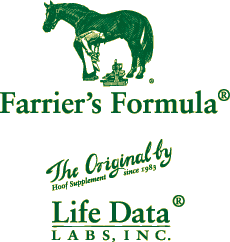Thrush Solution
|
This appaloosa gelding, Ace, is the sweetest best behaved, eager-to-please horse around. Unfortunately when I started working on him he had thrush so bad in all four feet that he was sore for 3 years before I met him. Ace lives at Muir Beach, CA where it can get wet in the winter. He was moved to a dryer climate for a couple of years, but still had the thrush when he came back. I was able to give him immediate relief and cure the thrush, and the pictures below document how it was done. |
|
In the next two photos, below, the horny frog (insensitive frog) has been eaten completely away by thrush, which is exposing the sensitive frog (ouch). It has eaten so deeply that it has created a condition known as interbulbular dermatitis. Normally a hoof pick couldn't be inserted into this area. I've place the hoof pick in there (in two of his feet) to give you some perspective on just how deep the thrush infection is. This horse is getting sand in there where the hoof pick is, and it's very irritating to him. He jumps every time a pick is drawn through this area. If your horse jumps from the pressure of a hoof pick, it's from thrush exposing sensitive tissues. Sand and gravel have been driving this poor guy nuts. This condition is like having sand between your toes inside a shoe. It get raw in there. |
|
If you look closely in the picture below you can see the line in the frog that delineates the sensitive frog from the horny frog. About a quarter inch layer of horny frog is missing from the rear portion of the ground surface side. |
|
The most economical solution with the least amount of effort in the long run is to use a frog support pad and two-part impression material with copper sulfate crystals placed directly against the foot and down in the cavity created by the thrush. The picture below shows the impression material that was taken out of one of his feet. Notice how deep the infection was into the back of the frog. By coating the impression material with copper sulfate before it hardens (it's still flexible) into the shape of the foot a layer of thrush killer (copper sulfate) is laid down that is effective for up to 8 weeks between shoeings. That's right, I completely seal up the foot for 8 weeks with an active case of thrush, and when I open it for the next shoeing, it's completely clean of thrush. That's a hard one initially for my clients to believe, but I have never had a case that I wasn't able to clean up using this technique. I deliberately show the condition of the foot after removing the shoes, pads, and impression material after each shoeing so that my clients feel at ease that this process is definitely working and they are not rotting out their horses feet with this procedure. I originally started using the copper sulfate to keep thrush from growing inside of feet that I was padding, and then I noticed that not one horse I ever padded for other reasons with plastic frog support pads, impression material and copper sulfate ever got thrush. The beauty of this treatment is that the horse owner doesn't need to do any further treatment between shoeings. They don't have to clean out the frogs anymore. They don't have to daily apply thrush eradicating solutions to the feet. They don't have to apply any solutions whatsoever between shoeings. In fact, the shoes are mostly self-cleaning with no rocks getting logged in deep crevices the feet. The horse can move through water and wet areas the same as before. In fact, because they are not sore from the thrush and are now padded from sharp rocks and their entire foot is now weight-bearing, they usually look and act a lot friskier. In this case, Ace immediately went completely sound, even though it took about 8 months for the deep crevice to grow back in. A lot of the solutions that are poured into these kinds of thrush infections are painful to the horse because they are caustic. Don't use diluted solutions of bleach, or iodine solutions on feet that have exposed sensitive tissues. I've seen these treatments lead to horse behavior problems with otherwise well-behaved horses because they begin to associate working with their feet with pain. Thrush is an anaerobic bacteria that can't live in the air. Once I can get the crevice in the back of the frog to be wider and less deep by keeping copper sulfate against the foot eventually there is no need for pads. Each time I trim and/or shoe the horse I can remove the fine layer of thrush that every horse seems to carry in his feet, and I can widen any areas with my hoof knife that might get closed over and harbor the bacteria as long as I see the horse every 6 to 8 weeks. The holes in the impression material are where the copper sulfate was laid against the foot so as to impregnate the layer of tissues with it. It dissolves and leaves the hole marks when I remove the material between shoeings. |
|
The ridge in the back of the frog subsided in subsequent shoeings as the frog was able to regenerate itself when thrush wasn't eating it faster than it could grow. |
|
In the pictures below of Ace's feet taken after about 4 shoeing with the impression material and copper sulfate above notice how nice and marbled the frog is with no sign of thrush. Ace has been shod with regular shoes now for the past two years. He is never lame. |
|
Ace's new perfect feet below.
Notice the evidence of penetration of the tissues by the
copper sulfate (blue). That's why the thrush can't
grow in the foot. This is what your horse's foot
should look like after your farrier trims it for shoeing.
Because the grooves are widened the foot will naturally
clean itself between shoeing, stones won't lodge in the
crevices so easily, and the owner can easily clean out the
frog with a hoof pick before and after riding. This is
a healthy foot. |


